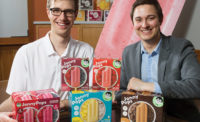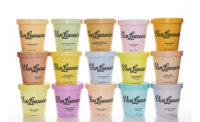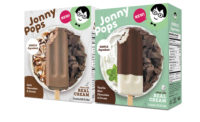Frozen novelties is a $4.9 billion annual business. Sales were up 4% but unit sales rose only 2.2% in the 52 weeks ended Feb. 19, 2017, according to IRI, a Chicago-based market research firm. Nestle, Unilever and Wells Enterprises dominate the category. One little start-up that is gaining traction is JonnyPops, a five-year-old business based in the suburbs of Minneapolis. (See related article)
From a nondescript one-floor brick building bordering a residential area in St. Louis Park, JonnyPops manufactures stick novelties in seven flavors. The administrative offices and manufacturing area share space in a warehouse with Nordic Ware, the maker of the Bundt pan and other items for baking and cooking.
Prior to moving into the space in 2014, JonnyPops founders Erik Brust and Connor Wray were manufacturing their products in a commercial kitchen they rented as needed. Brust and Wray brought in a few pieces of their own equipment and made pops during the week. On the weekends the space was usually booked for events and unavailable to the young entrepreneurs. Later, they moved into the Nordic Ware warehouse.
Since moving into their present location, they have expanded several times. The latest expansion project was adding a second line for making novelties. The business has about 12 full time employees, and everyone does a little bit of everything. On the day Dairy Foods visited, Brust was in a hairnet on the floor operating the novelty filler/freezer. Wray led a tour of the facility.
Mixing, filling, wrapping
Pasteurized mix arrives on pallets from a local dairy processor. The cream is blended with fruit, purified water, cane sugar and a pinch of salt. That simple, five-ingredient recipe is no trade secret. It’s printed on every carton. Strawberry is the No. 1 flavor sold, but during our visit, the line was making pineapple-coconut pops.
In the mix room, the company was preparing the pineapple and coconut recipe. Just exactly how and for how long JonnyPops mixes the ingredients is a trade secret.
As the mix was being prepared, Wray showed how the plant was prepping for tomorrow’s run, which was to include the chocolate-coffee flavor. Two thousand pounds of real chocolate (not a derivative, Wray noted) were being melted in one vat. Elsewhere in the plant, an associate weighed out ground coffee and filled muslin bags. These were to be cold-brewed overnight. Making coffee in-house, rather than buying an extract, allows JonnyPops to maintain its quality, Wray said.
When the pineapple and coconut mix was finished, it was poured into 300-gallon totes which were rolled to the filling room. The mix was pumped into the filler. JonnyPops has two lines of novelty makers. This second line has allowed the company to increase its output. It fills the same recipe on both lines or makes two different products at the same time.
The distinctive fluted molds are filled with the mix, and the 78-gram pops are frozen quiescently. The mix yields a dense, low-overrun ice cream. Wray didn’t reveal the specifics, but a Dairy Foods sensory evaluation confirmed that the ice cream is a premium-quality.
As the molds reached the end of their ride through the freezing process, an associate unmolded the pops and placed them into a vertical feeder. These are gravity-fed onto a conveyor leading to the wrapping machine. After wrapping, the novelties were conveyed through a window into the packing room. Date and batch codes were printed on each wrapper.
Teams of employees place the wrapped pops into bays on the conveyor, which moved them into the cartoning area. A cartoner forms the box and three novelties were pushed inside. (JonnyPops also produces a 16-unit pack for club stores.) After the cartons were sealed, they passed through a metal detector and checkweigher, which determined that the proper count of units was inside.
The cartons were conveyed to a freezer, where employees built pallets. They moved the pallets into a small onsite freezer. Later, the pallets were transported to an off-site distribution center. Every evening, the palletizing room is warmed and cleaned of ice buildup. The next morning, the temperature in the room is brought down below freezing.
The company has been running one shift, but by the summer Brust said he’ll be scheduling extended shifts or adding a second one. Making a product with seasonal demand (like ice cream novelties) makes it difficult to keep lines running regularly. The introduction of a new pop for school foodservice accounts will remove some of the seasonal aspects of manufacturing.
Cleaning and testing
All of the novelty molds are cleaned out of place after every flavor change and at the end of the day. The Minnesota Department of Agriculture and the federal Food and Drug Administration inspect the plant regularly. Pathogen samples are sent to an outside lab for testing.
Finished goods samples are removed from the line throughout the day for testing. The day’s production is placed on a quality assurance hold before being released for sale.
Inevitably, some wrapped bars don’t make it into cartons and fall into a bucket. These units will be discarded rather than unwrapped and re-worked. The company won’t re-work the product for reasons of food safety and for quality control, Wray said.
All of the employees have to be invested in quality, Wray said. Quality cannot be the responsibility of only those at the end of the line. Employees are cross-trained to avoid repetitive motion, and so that they can fill in for their co-workers if one is absent. Co-founder Brust has been checked out on the equipment so that he can pitch in when needed.
JonnyPops’ brand promise is “A better pop for a better world.” Wray said “that not only means that we make products that are better for you, but also that they are great quality and high-integrity products. When we look for ingredients to bring in, we look for absolutely the best. We want the best, the ripest fruits that are going to have the right taste, the right sweetness, and importantly for our product, the right texture.”
He said the company also wants to make sure its suppliers and purveyors are making the safest products as well.
With only one product (in seven flavors), the company is not distracted by manufacturing too many SKUs or by co-packing other brands’ products.
“Everything we make here, every JonnyPop is made by us, and everything that we make here is a JonnyPops. And so that means that we are putting our name on every single product that goes out to the store. And that promise of making a better pop is not true if our pops are not safe, and customers can’t count on them to be that quality experience and that safe experience,” Wray said.
JonnyPops’ production is made to order. The company is not making inventory. As novelties were unmolded and were being wrapped, Wray noted with satisfaction that consumers are eating JonnyPops as fast as the company can make them. JonnyPops is claiming its share of a $4.9 billion market.









